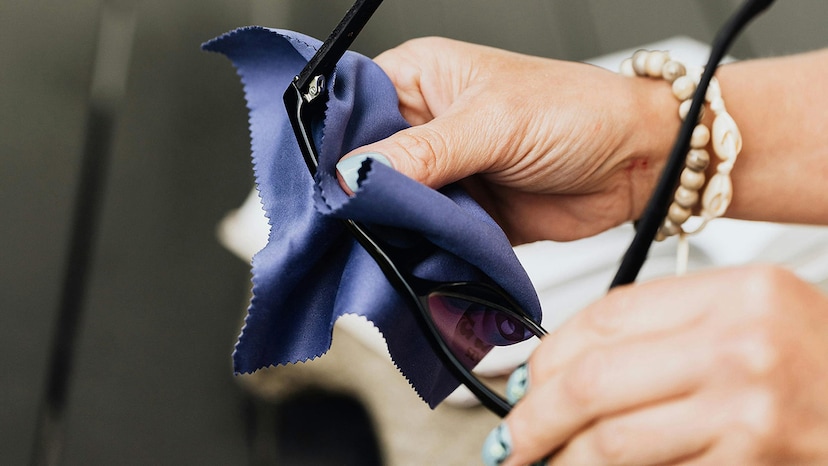What if the frame is broken or becoming outdated?
Glasses can wear out, get damaged, or become outdated. So, whether you have a crack, screws that are a little loose, or just feel that it is time to update the look of your eyeglasses, replacing your glasses frames is not unusual. For most of us, the idea of having to go to an optician or eyewear store to have the frames replaced can come across as a burden, especially when there’s a chance for a DIY solution.
A damaged or old frame can be uncomfortable and affect the performance of your lenses. If your current frame no longer fits comfortably, is pinching, or just isn’t your style, then the next step is to try new frames. But, before you try replacing frames on your own, it's important to understand the risks and requirements of the task.
Can I change the frame at home? Yes or no?
The idea of fixing your glasses frame at home might sound tempting, especially if you’re time-poor and don’t want to spend on gas or transportation to go to an optician. Yes, but here are the limitations. For some eyeglasses, you can replace a frame at home, but it's not recommended for all types. If you have standard lenses and a simple frame, you might be able to replace the frame with tools and patience.
But not all glasses are designed for easy at-home repairs. Specialty frames, or those that need special tools to adjust, may also need a pro's touch. Furthermore, there are extra precautions that you need to take in order to avoid damaging lenses that have some special kind of coating (such as AR coating) or if they have a prismatic prescription. We aim to help you understand if the frame type is replaceable as a DIY and if you have the appropriate tools and experience to carry out the job safely.

Frames that can be replaced at home
Some frames are simply more adaptable to home replacement than others. If you’re thinking of maintaining or replacing broken glasses on your own, the following are some easier-to-manage types of frames:
Plastic & acetate frames:
These frames are the easiest to repair at home. These frames are pliable and lightweight and can usually be bent and/or replaced without specific tools. Acetate frames are also commonly screwed, which can be removed to replace the frame. Be careful when removing or reinstalling these frames, as they can break reasonably easily, and this could mean you’re left with holes in the door in case you order a new one.

Loose screw repairs on metal frames:
Metal frames are generally stronger than plastic frames, but they can have the occasional loose screw problem. In the event the frame is otherwise still sound, screws can be changed fairly easily by you if you have the right tools. Eyeglasses repair kits may include mini screwdriver sets, and they can be used to tighten or replace screws on metal frames. If the damage is minor, like a loose screw or hinge, you may not require a professional to address it. But for more complicated metal frame problems (like broken or bent frames), you should consider seeking expert help.

Interchangeable or modular frames:
Some of eyeglass frames are interchangeable, with removable parts like temples, nosepads, and lenses. These frames often include a means for replacing the temples, nosepads, and lenses so that a user can easily change the look or function of their glasses. The best part is many popular eyewear makers offer modular frames you can customize yourself. These frames are perfect for a do-it-yourself replacement because of their low-maintenance functionality.

Sure, for cheap plastic or acetate frames and frames that have a removable part like a screw, there’s absolutely a point to replacing the frames yourself. You’ll just need to make sure that the new frame is the correct size and style for your prescription lenses.
Frame types not appropriate for home replacement
While there are at-home workable frames, some require tools, resources, skills, or a level of expertise that many people do not have. Below are the frame types that are generally unsuitable for home replacement:
Rimless & semi-rimless glasses:
These are trickier to replace at home due to their intricate design. As the name implies, rimless frames have no frame that surrounds the lens, and the lenses are simply screwed or wired onto the arms. Semi-rimless Semi-rimless frames have a frame around the top half of the lens (and sometimes around the bottom half, too) but no frames around the portion that rests on your cheek under the eye. This frame needs a special screwdriver, and I know how to put lenses in this anyway so as not to damage the frame or lens. You could also use a pro-optician or eyeglasses tech to fix or replace one of these glasses.

Specialty coated or prism lenses:
Lenses coated with anti-reflective, UV, or specialty coatings are delicate and can be easily scratched or damaged when being replaced. In addition to this, lenses with prismatic prescriptions—that correct vision problems such as eyes working in unison—need to be handled with exacting technique to not change the prescription. That is to say, you can’t just pop these lenses into a fresh pair of frames without throwing the prescription into question. As for these types of lenses, please consult a professional.

High-index or thin lenses:
These lenses correct higher degrees of refractive error with thinner, lighter lenses that might be more delicate than standard lenses. These lenses are not shatterproof and should be handled with the utmost care to prevent breakage or scratching (especially when inserting them into a new frame). Attempting to replace these lenses at home without the right tools or the right know-how could result in injury or damage.
Special frame materials (titanium, wood, or custom frames):
Some glasses, like titanium frames or wood frames, need special tools for fit and focal lens replacements. These can be more stiff/less flexible than plastic & acetate frames. Without the right equipment and know-how, you can easily twist, crack, or ruin a frame by trying to do this to these types of frames on your own.

But if you have frames constructed from more complex materials, or if your lenses have special coatings or prescriptions, then you’re better off having a professional handle the frame replacement.
Re-bedding of broken glasses frames: how you can do it easily and safely
If you’ve made the decision to replace your eyeglass frame at home, it’s important to go about it in a safe, efficient manner. The method will vary based on the frame style as well as the condition of your existing eyeglasses, but here is a broader step-by-step that should help you to replace glasses frames yourself without risk:
Tools you will need:
- Small screwdriver set
- Replacement frame
- Microfiber cloth
- Lens cleaning solution
- Lens cleaning wipes
- Kit for repairing plastic or acetate frames (optional)

Step-by-step process:
Lenses off the current frame:
The first step is to remove your old lenses off your current frame gently. In most cases, you’ll have to unscrew the screws on the arms or hinges first. Don’t forget to set them aside in a safe place to avoid losing them.
Check the lenses:
When you take the lenses out, check for damage, such as cracks or scratches. If the lenses are in good shape, you may be able to reuse them in the new frame. If the lenses are broken, you’ll need to order new ones.
Prepare the new frame:
Check the size and style of the new frame for the lenses before inserting them into place. If the frame is interchangeable or a modular frame, follow the manufacturer’s instructions for mounting of the frame prior to lens mounting.
Insert the lenses into the new frame:
Carefully position the lenses into the new frame. Depending upon the frame style, this may include affixing the lenses in place with screws, clips, or the like. Please put the lens gently, and you also can press hard them to be all around the both side of the frames. Don't too hard; It is avoid for deformation It suits for the most face shapes A slip, read and-resistant nose piece, adjustable rubber in the glasses frame_ Suitable for any climate and weather conditions.
Tighten the lenses:
If your frames have screws that keep the lenses in place, tighten them a turn or two with the small screwdriver. Be cautious not to overtighten and warp the frame or strip the screws
Check the fit and alignment:
Once the lenses are installed, check the fit of your glasses. Make certain the lenses are centered and properly aligned. Try the frame on and turn around the temples for perfect comfort.
Cleaning the glasses:
After installing the new frame, clean the lenses and the frame with the lens cleaning solution and the microfiber cloth. This will wipe away any dust, grease, or fingerprints that have accumulated on the frame and lenses and leave you with glasses that will be both functional and great-looking.
Conclusion
Swapping out your eyeglass frames at home is a DIY project that you can accomplish with certain types of glasses, such as plastic or acetate frames, or when it’s just loose screws on metal frames. But not everyone can fix broken glasses at home or swap the frame. Expert patience is required for rimless, semi-rimless frames featuring lenses or coatings with certain special properties.
If you’re confident in your skills to make the replacement, step-by-step instructions can help you replace the frames at home safely. If your glasses are constructed with more complex materials, like wire, or you have certain types of lenses, you probably want to see a professional to have your glasses replaced so the job is done right and safely.
By knowing which frames are repairable at home, as well as the tools and methods to use, you can avoid an expensive repair shop bill when it comes to fixing your glasses. But always exercise caution, and when in doubt, seek advice from a professional to prevent damaging your lenses or your frames.




















